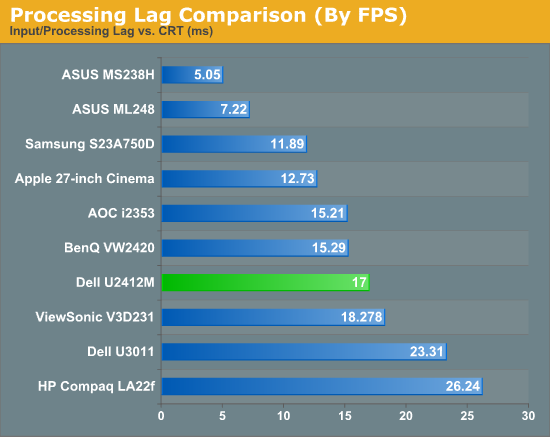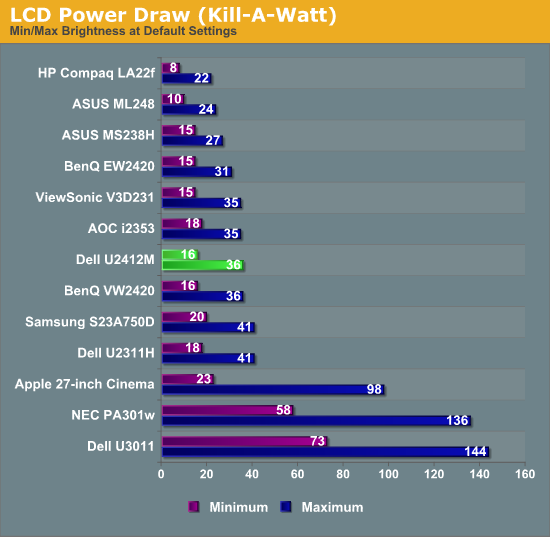Dell U2412M - 16:10 IPS without Breaking the Bank
by Chris Heinonen on February 28, 2012 9:00 AM ESTDell U2412M Input Lag and Power Use
For testing lag, I am trying a new solution to our previous testing method. I’m trying out SMTT, which is designed specifically for measuring lag in LCD displays. Using DirectX it manages to push over 1,000 frames per second to a display, allowing for millisecond accuracy instead of relying on time demos that often run well below that threshold. Using this method, we can actually determine two different values: The input lag for the LCD to initially respond, and then the total lag from when the new frame is received to when it is completely drawn and at full brightness. This last one is the overall important value, as it is what gamers would be most concerned with. It’s important to have as low an "input lag" as possible so that even if the screen isn’t fully drawn yet (the pixels will be changing over) you will be able to begin to get that feeling of responsiveness.

Here we see that the overall lag value measured OK, at 17ms. The input lag, which was also measured, was just under 2ms, which indicates that the Dell responds very quickly, and then it’s just a matter of the pixel response time. One thing to keep in mind here is that the 17ms response time is the total time from input to peak brightness, and then it takes 15ms to fall back to another value. When I actually look at the test subjectively and not objectively, you can certainly see the change in the pixel after 7-8ms of time. So I could report it as 8ms of lag, as that’s about what I think you would experience in a real world situation, but the worst case scenario seems to be 17ms, which is what I’m choosing to report as that’s the objective number.
The CRT still comes in perfect, and that’s what the LCD should aim to do; picking a number that gives a better result, even if it might be more applicable to the real world, feels like cheating. Perhaps we will get a future display technology (like OLED or CrystalLED that I saw at CES this year) that will bring us back to CRT response times, but until that happens I’m going with the objective, worst case measurement. I will report the “real world estimate” along with it, though, so you can use that for your own judgment. Please let me know what you think of this in the comments section.
I made the assumption that with a larger panel and the 300 nits of light output that the Dell would not be the most eco friendly panel I had seen. Happily I found this to not be the case. It drew just 36 watts at maximum brightness and only 16W at minimum brightness, less than even the 23” Dell U2311H from last year. I don’t know if it is more efficient LED lights, or a more transparent panel that allows more light through, but Dell did a good job keeping the power use low on the U2412M.











143 Comments
View All Comments
Death666Angel - Tuesday, February 28, 2012 - link
Honestly, if I had to chose between 16:9 with 1080p or 16:10 with 900p, I'd take 16:9. The real issue people argue is that the 24" market has gone 16:9 with 1080p. No gamer or other user would go with anything below 22" unless there are space constraints.piroroadkill - Wednesday, February 29, 2012 - link
The U2410 is not a budget screen by any measure, though, and although it is "old", it is not actually old. It is still being sold alongside the U2412, because the U2410 has a true 8-bit S-IPS panel, 10-bit processing, wider gamut (almost all of AdobeRGB) and a slew of inputs.It's still relevant.
seapeople - Wednesday, February 29, 2012 - link
Dude, nobody cares about your low resolution 16:10 screens.Only very strange aspect ratio freaks think 1440x900 is better than 1920x1080 anyway.
It's cool to see a budget 1920x1200 monitor out there.
Burner.Tom - Tuesday, February 28, 2012 - link
The direct competitor to reviewed Dell monitor is HP ZR2440w 24-inch LED Backlit IPS Monitor, not ZR24 - its the previous generation.PS: Dell isnt the LCD panel maker - its LG, probably model LM240WU8.
Burner.Tom - Tuesday, February 28, 2012 - link
HP ZR2440w 24-inch LED Backlit IPS Monitor - Overviewhttp://h18000.www1.hp.com/products/quickspecs/1414...
darwinosx - Tuesday, February 28, 2012 - link
The HP is a tad bit more expensive but a much better deal with much better service. I'm surprised the author didn't know this was actually the competitor for this Dell not the old HP monitor.cheinonen - Tuesday, February 28, 2012 - link
For competitors I was specifically search for other IPS/VA panels with 1920x1200 resolution that were within $75 (or 25%) of the price of the Dell. The only model that came up at the time of searching was the older HP, which is why it was listed. There are a lot of other 16:10 IPS/VA panels, but once you got past being within 25% of the price, I didn't consider them direct competitors anymore.Burner.Tom - Tuesday, February 28, 2012 - link
U2412M and ZR2440w are direct competitors from hardware point of view (LCD panel) but the price is really better in Dell case.In Slovakia, its 253€ for Dell and 350€ for HP, both have 36 months On-site warranty. The question is - why is HP so expensive? I guess there must be something cheaper used in Dell monitor (power circuit, controller board, ...). Who is OEM of the Dell? ZR24w and ZR2440w are made by Tatung.
JarredWalton - Tuesday, February 28, 2012 - link
Wait, what makes the HP a "much better deal"? I'd call service of HP and Dell monitors pretty close to equal, and the HP is $50 more for the lowest price I can find. 15% more is only "a bit more"? They're both eIPS AFAICT, so other than the nebulous "service and support" aspect, why would one be better than the other?Touche - Tuesday, February 28, 2012 - link
HP has more inputs, a scaler for 1:1, thus can be hooked up to consoles, and better RTC control. The latter makes it a bit more responsive, but former to have higher input lag. Comparing several reviews, HP tends to have better uniformity.